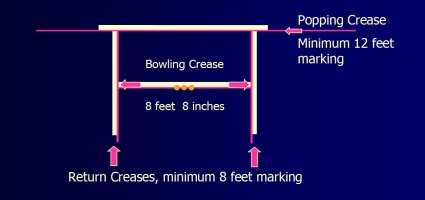
 |
| Index | |
|
|
|
|
|
| Creases (Popping, Bowling and Return)  There are three creases marked at each end of the pitch, though one of them is marked twice, either side of the wicket. Perhaps the least important of these is the bowling crease, on the back line of which the stumps are set. This crease used to have significance in determining No balls under earlier codes of Laws but, these days, exists only as a marker for the ends of the pitch and the positioning of the wicket. The other two creases are of much greater significance. The popping crease is 4 ft (1.22m) in front of and parallel to the bowling crease and runs from one side of the field of play to the other. Though it is only required to be marked for 6 ft (1.83m) either side of an imaginary line joining the middle stumps at each end, the marking is often extended much further to help umpires judge run outs. If the batter has some part of his person or equipment or is holding his bat grounded behind this crease he is said to be in his ground and cannot be Run out or Stumped. The return crease is the one that is marked twice, each time 4 ft 4 in (1.32m) either side of that imaginary line joining the middle stumps at each end, but at right angles to the popping crease and running from there back to the boundary at that end. Again it is only required to be marked for a much shorter distance - a minimum of 8 ft from the popping crease. The popping crease and the return crease are essential to the umpire's judgement of certain types of No ball. The creases should not be confused with the crease markings - the white lines on the turf. The creases themselves are the inside edges of those lines - the edges nearest the stumps at that end. Until the middle of the nineteenth century creases were not marked by white lines but by grooves - or creases - cut into the surface of the turf - hence their name. The popping crease is thought to have achieved its own unusual name because of a requirement in the early years of the game that the batsman placed (or 'popped'?) the end of his bat into a 'popping hole' at each end of the pitch to signify the completion of a run. |
||||||